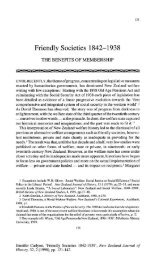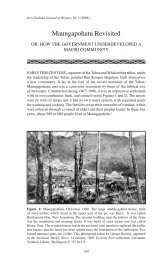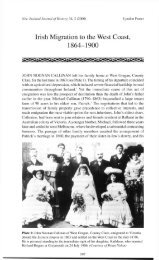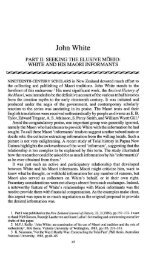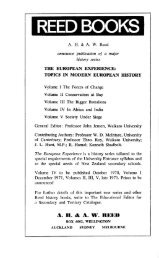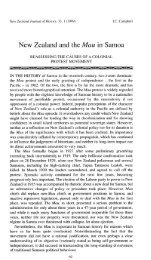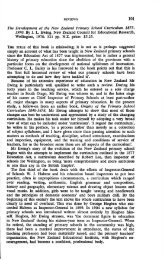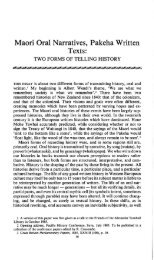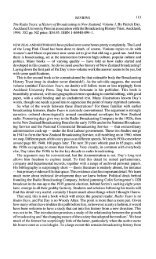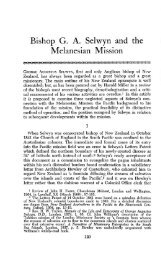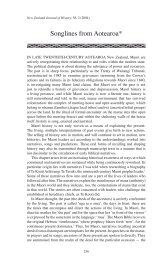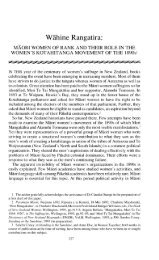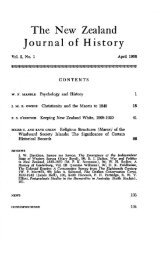John White - New Zealand Journal of History
John White - New Zealand Journal of History
John White - New Zealand Journal of History
You also want an ePaper? Increase the reach of your titles
YUMPU automatically turns print PDFs into web optimized ePapers that Google loves.
<strong>John</strong> <strong>White</strong>: The Making <strong>of</strong> a<br />
Nineteenth-Century Writer and Collector<br />
<strong>of</strong> Maori Tradition<br />
JOHN WHITE looms large in the scholarly topography <strong>of</strong> nineteenth-century<br />
<strong>New</strong> <strong>Zealand</strong> in the field <strong>of</strong> Maori studies and where recourse is made to<br />
collections <strong>of</strong> Polynesian tradition, although he may not be well known to<br />
historians. 1 He grew up in North Auckland, learnt Maori, and from quite an early<br />
age displayed a growing fascination with the history <strong>of</strong> the Maori society he<br />
encountered around him. He produced a string <strong>of</strong> sketches, lectures, articles,<br />
novels, and finally the remarkable collection <strong>of</strong> Maori traditions, the Ancient<br />
<strong>History</strong> <strong>of</strong> the Maori, which he prepared virtually single-handed towards the end<br />
<strong>of</strong> his life. This impressive series <strong>of</strong> volumes was envisaged as the definitive<br />
collation <strong>of</strong> Maori historical texts, but publication was terminated before all <strong>of</strong><br />
it could see the light <strong>of</strong> day. Its unpublished parts now serve as a lode <strong>of</strong><br />
knowledge, sometimes mined without acknowledgement by subsequent generations<br />
<strong>of</strong> scholars.<br />
Somewhat surprisingly, given the importance <strong>of</strong> the collection, little has been<br />
heard about the editor <strong>of</strong> the Ancient <strong>History</strong>. How did he come to this work?<br />
What motivated him? What did he think <strong>of</strong> Maori people or their culture? In<br />
short, what can be discerned in his life that widens and deepens our understanding<br />
<strong>of</strong> <strong>White</strong> as a scholar <strong>of</strong> Maori?<br />
Any recounting <strong>of</strong> <strong>White</strong>'s biography relies heavily upon a singular document<br />
he kept between the ages <strong>of</strong> 20 and 24 (that is, 1846-1850). It is simply titled,<br />
'PRIVATE JOURNAL, Begun Mata, June 5 1846 Friday'. It consists <strong>of</strong> daily<br />
entries kept between 5 June 1846 and 10 April 1848, and more sporadically till<br />
late 1850. Intended partly as a record <strong>of</strong> reading material, and a private account<br />
<strong>of</strong> his thoughts, it gives a revealing insight into details <strong>of</strong> his day-to-day work,<br />
his literary readings, the kinds <strong>of</strong> information he was gleaning from local Maori,<br />
and his own candid opinions <strong>of</strong> individuals he met, Maori or Pakeha, many <strong>of</strong><br />
whom are poorly identified, if at all. It covers only his earlier, formative years,<br />
but the very personal nature <strong>of</strong> the diary—he intended to let only a future wife<br />
read it—means that this work is the most important document we possess about<br />
<strong>White</strong>. 2<br />
1 I should like to thank Niel Gunson, Ruurdje Laarhoven, and Ioanne Lafoa'i for commenting<br />
on and correcting an earlier draft <strong>of</strong> this paper.<br />
2 <strong>John</strong> <strong>White</strong>, 'Private <strong>Journal</strong>' (PJ), 1846-50, Alexander Turnbull Library (AIL), Wellington.<br />
References and quotations are taken from the autograph copy. In 1932 a typescript was made at<br />
157
158 MICHAEL REILLY<br />
Little direct information exists on <strong>White</strong>'s life before he was 20. We know he<br />
was born in the village <strong>of</strong> Cockfield in Durham, England, on 3 January 1826. His<br />
parents were Francis and Jane <strong>White</strong>. His father was a blacksmith. An uncle,<br />
William <strong>White</strong>, was a Wesley an missionary in <strong>New</strong> <strong>Zealand</strong>. 3 In 1834 the family<br />
followed William to <strong>New</strong> <strong>Zealand</strong>, enduring a shipwreck on Norfolk Island,<br />
where the swift intervention <strong>of</strong> convicts saved their lives. Francis <strong>White</strong> later<br />
petitioned the <strong>New</strong> South Wales authorities on the convicts' behalf. 4 Towards<br />
the end <strong>of</strong> 1835 the <strong>White</strong>s finally reached <strong>New</strong> <strong>Zealand</strong>, settling in the<br />
Hokianga. When <strong>John</strong> <strong>White</strong> was in his early teens he accompanied his father on<br />
a business trip to England. He seems to have spent a period in boarding school<br />
there, and had returned to <strong>New</strong> <strong>Zealand</strong> by late 1840. 5<br />
The Hokianga by this time, judging from the journal, had become a rather<br />
isolated place. Europeans were scattered about the district and formed small,<br />
seemingly self-sustaining communities amidst the larger Maori population.<br />
Contact with the outside world was by ship, travelling to Auckland, Sydney or<br />
England. Otherwise, trips were made overland, by horse, by foot, or by riverboat.<br />
<strong>White</strong>, like other early colonists, was a jack-<strong>of</strong>-all-trades, undertaking chores or<br />
repairs around the house, preparing the ground for crops, helping to cut and<br />
transport timber, herding cattle, or pig hunting. There were also weekly prayer<br />
meetings and chapel services on Sunday, followed by social visits. <strong>White</strong>, who<br />
by his early twenties had learnt to play some musical instruments, would be<br />
called upon to entertain such gatherings. After he had begun to write, he might<br />
read examples <strong>of</strong> his creations to family and visitors. There was also ample<br />
opportunity for individual recreation. <strong>White</strong> spent much <strong>of</strong> this time reading,<br />
writing, or collecting Maori traditions. Family life was in some respects<br />
reasonably relaxed. <strong>White</strong> did not always feel up to attending chapel or prayer<br />
meetings and does not seem to have suffered parental discipline for such lapses.<br />
The most serious shortcoming <strong>of</strong> life in the Hokianga, at least in <strong>White</strong>'s own<br />
opinion, was the lack <strong>of</strong> formal education. By the time he began his private<br />
journal, he was acutely aware <strong>of</strong> this. He admitted several times to having only<br />
a poor knowledge <strong>of</strong> spelling and grammar, a feature attested to by his phonetic<br />
Tumbull <strong>of</strong> this text, which was then owned by the collector, Sir Joseph Kinsey. He had bought it<br />
and other <strong>White</strong> items from the latter's two youngest daughters. Two carbon copies were also made;<br />
one resides in the Turnbull and the other in the Auckland Institute and Museum Library (AIM).<br />
The typed text varies occasionally in its reading from the original, a not unexpected result <strong>of</strong> <strong>White</strong>' s<br />
notoriously difficult handwriting. I intend preparing an edition <strong>of</strong> the journal for publication. I<br />
should add that at the time I read the top copy <strong>of</strong> the typescript in 1980, it had a series <strong>of</strong> valuable<br />
attachments, including photographs <strong>of</strong> <strong>White</strong> demonstrating 'drill' positions for Maori weaponry.<br />
These were used subsequently as the basis for the illustrations in the Ancient <strong>History</strong> <strong>of</strong> the Maori.<br />
3 <strong>John</strong> <strong>White</strong>, 'Recollections <strong>of</strong> Myself, 1 January 1846, in 'Notebook 1848', ATL; PJ, 5 May<br />
1847.<br />
4 Cross to Phillipps, 6 August 1875, AO 75/639, Archives Authority <strong>of</strong> <strong>New</strong> South Wales,<br />
Sydney; 'Hannah's Reminiscence' (Hannah was a younger sister <strong>of</strong> <strong>John</strong>), manuscript owned by<br />
Mr L.E. Martin, Wellington, and cited with his permission. My attention was initially drawn to these<br />
papers by Dr Claudia Orange, Dictionary <strong>of</strong> <strong>New</strong> <strong>Zealand</strong> Biography, Wellington.<br />
5 PJ, 7 May 1847; 'Hannah's Reminiscence'; A. H. Reed, '<strong>John</strong> <strong>White</strong>: a biographical sketch',<br />
in A.W. Reed, ed., Revenge: a Love Tale <strong>of</strong> the Mount Eden Tribe, Wellington, 1940, p. xii.
JOHN WHITE 159<br />
renderings and poor handwriting. 6 However, not all his siblings agreed. Hannah,<br />
a younger sister, writing late in life, believed they had had the very best teaching<br />
possible. This included attendance at the mission school, the attentions <strong>of</strong> 'an<br />
educated lady' as private governess, and the instruction <strong>of</strong> Mrs Eliza <strong>White</strong>, their<br />
aunt, described as being 'very well educated and refined'. 7 <strong>White</strong> still regularly<br />
attended the mission classes in his early twenties, though it was only evening<br />
tuition once a week. 8 It apparendy consisted <strong>of</strong> reading and writing exercises, and<br />
rote learning, <strong>of</strong> weights and measures for instance. 9 By 1846 he had begun to<br />
supplement his meagre learning with a regimen <strong>of</strong> self-education.<br />
To achieve this ideal <strong>of</strong> improvement by self-instruction, <strong>White</strong> instituted a<br />
programme <strong>of</strong> reading. Along with his music-playing, these activities had the<br />
added bonus <strong>of</strong> deflecting his own sense <strong>of</strong> isolation in 'this wild uncouth land',<br />
and <strong>of</strong> enabling him 'to pass an evening <strong>of</strong> our monotonous life away in a slight<br />
pleasure'. 10 Reading formed his principal hobby, all day if the book interested<br />
him, <strong>of</strong>ten till midnight or as a means <strong>of</strong> passing the time on boat journeys. 11 He<br />
was able to extend the range <strong>of</strong> reading matter through neighbourly borrowing<br />
from fellow Hokianga settlers or sympathetic visiting ships' <strong>of</strong>ficers. 12 His<br />
choice <strong>of</strong> reading was not restrictive; quite the contrary, he maintained a eclectic<br />
approach. Anything in print was sufficient to catch his interest. Nevertheless, it<br />
is possible to discern, amidst the diversity, certain recurring types <strong>of</strong> reading. In<br />
the light <strong>of</strong> his later scholarly contribution to Maori history, some are especially<br />
noteworthy.<br />
The first <strong>of</strong> these reflected his interest in oral traditions and, in particular, the<br />
literature <strong>of</strong> Scotiand, as represented especially in James MacPherson's Poems<br />
<strong>of</strong> Ossian. This work, when it was issued, had seized the imagination <strong>of</strong><br />
eighteenth-century Europe. It claimed to contain the poems composed by<br />
Ossian, the son <strong>of</strong> Fingal, a famous third-century Scottish king. On 12 April 1847<br />
<strong>White</strong> was finally able to obtain a copy shipped from Sydney, exulting, 'what<br />
pleasure I shall receive'. 13 That <strong>White</strong> himself was already very interested in the<br />
subject is shown by his unusual action <strong>of</strong> obtaining a personal copy from<br />
Australia. He very soon compared the poems to Maori song poetry; for instance,<br />
writing <strong>of</strong> the poem 'Fingal', 'many <strong>of</strong> my NZ things will be as wild as this poem,<br />
that is be as disconnected in its parts compared with a modem poem though my<br />
authors are more elaborate than Ossian'. 14<br />
The Ossianic poems had not only been explosively popular, but had also<br />
aroused a major debate centring on their authenticity. <strong>White</strong> was familiar with<br />
6 e.g. PJ, 9, 15 September 1846.<br />
7 'Hannah's Reminiscence'. Eliza <strong>White</strong> seems to have run a school for Pakeha children during<br />
the 1830s and earlier 1840s. T.M.I. Williment, <strong>John</strong> Hobbs 1800-1883: Wesleyan Missionary to<br />
the Ngapuhi Tribe <strong>of</strong> Northern <strong>New</strong> <strong>Zealand</strong>, Wellington, 1985, pp. 96, 184.<br />
8 PJ, 4 September 1846; 1 January 1847.<br />
9 PJ, 9, 15 September 1846; 17 February 1847.<br />
10 <strong>White</strong> to unidentified friend, 5 May 1847, <strong>John</strong> <strong>White</strong> Papers, MS 75 (JWMS), A77a, ATL.<br />
11 PJ, 12, 15 February 1847; 27 June 1847; 19 October 1847.<br />
12 PJ, 25 June 1847; 29 October 1847.<br />
13 PJ, 12 April 1847.<br />
14 PJ, 13 June 1847.
160 MICHAEL REILLY<br />
some <strong>of</strong> this literature. He appears to have read MacPherson's own defence <strong>of</strong><br />
his work, 'A Dissertation concerning the aera <strong>of</strong> Ossian', and agreed that ideas<br />
expressed in it applied to Maori traditions. 15 MacPherson had argued that<br />
Ossian's poetry was transmitted in an unbroken line from the third century,<br />
through succeeding generations <strong>of</strong> hereditary Court bards, and later still was<br />
retained in people's memory or committed to writing. 16 During such transmission<br />
he believed the poetry remained unchanged because the tradition's words<br />
were so well adapted to the 'common turn <strong>of</strong> the voice' that it was almost<br />
impossible to substitute them for others. 17 This notion <strong>of</strong> immutability allowed<br />
MacPherson to criticize later bards for making additions and interpolations and,<br />
on a few occasions, to rail against their allegedly corrupt or indecent language,<br />
or their unnatural and rather 'trivial' poems. 18 He rejected any insights into<br />
Scottish history or culture from these later works as being largely obscure or<br />
inaccurate. 19<br />
<strong>White</strong> seems to have taken such views very much to heart, for echoes <strong>of</strong> them<br />
can be found in the Ancient <strong>History</strong>. There he spoke <strong>of</strong> the hereditary '<strong>of</strong>fice <strong>of</strong><br />
the priesthood', men who had preserved the orally transmitted history in their<br />
memory by means <strong>of</strong> 'the most austere religious care' and rehearsal 'from age<br />
to age in the presence <strong>of</strong> the most select circle <strong>of</strong> youths'. 20 Like MacPherson,<br />
<strong>White</strong> also apparentiy believed these traditions were immutable and could only<br />
be corrupted by more recent generations; he once objected to a suggestion that<br />
Maori ought to comment on genealogy, arguing that they would only dispute its<br />
accuracy. 21<br />
The other major form <strong>of</strong> writing that had a pr<strong>of</strong>ound impact on <strong>White</strong> as a<br />
young man was poetry, especially Romantic poetry. He once described his<br />
feelings for verse thus: 'I know the words "Poet" or "Poetry" when they catch<br />
my eye in a book cause such a thrill in my heart that I could look at them for hours<br />
in a sort <strong>of</strong> trance, and still gaze on and find a pleasure'. 22 The most influential<br />
poet for <strong>White</strong>, at least at the time <strong>of</strong> his journal, was Byron. The extent <strong>of</strong><br />
<strong>White</strong>'s enthusiasm and the ambivalent family attitudes to such a figure are<br />
delightfully captured in the journal entries:<br />
in the evening made a framefor a likness [sic] <strong>of</strong> Byron which I had a present <strong>of</strong> by a friend,<br />
also introduced Byrons work into the palour [sic], for the firsttime <strong>of</strong> my life, Father asked<br />
me what book I was reading I told him, he asked me what I thought <strong>of</strong> him I said he was<br />
the Poet <strong>of</strong> Poets, and the greatest man since Adam, also that the world had treated him<br />
15 PJ, 14 April 1847. A substantial amount <strong>of</strong> literature has been produced about these poems.<br />
It is briefly summarized in my MA thesis, '<strong>John</strong> <strong>White</strong>: an examination <strong>of</strong> his use <strong>of</strong> Maori oral<br />
tradition and the role <strong>of</strong> authenticity', Victoria University <strong>of</strong> Wellington, 1985, pp.36-50.<br />
16 J. MacPherson, 'A Dissertation concerning the aera <strong>of</strong> Ossian', in The Poems <strong>of</strong> Ossian,<br />
London, 1805,1, pp. 16-17,19.<br />
17 ibid., p. 20.<br />
18 MacPherson, The Poems, n, p. 7n., p. 25n, III, p. 313n.<br />
19 MacPherson, 'Dissertation', I, p. 51.<br />
20 The Ancient <strong>History</strong> <strong>of</strong> the Maori, Wellington, 1887-90,1, pp. [iii], 1-2.<br />
21 Lewis to Native Minister, 2 June 1890, JWMS, B37c NO 90/373, ATL.<br />
22 PJ, 22 June 1847.
JOHN WHITE 161<br />
most infamously, we had a long chat on the same subject, fromthis time I date a change<br />
in my manner <strong>of</strong> reading, all these years I had to keep Byron locked up in my desk with<br />
many others, as they were prohibited books in our home. 23<br />
It should be added that such parental opposition probably stemmed more from<br />
an objection to Byron's scandalous reputation, which doubtless affronted the<br />
family's pious Wesleyanism, than from any antipathy to poetry. 24 It is recorded,<br />
on different occasions, that both parents remarked favourably on poetry, and<br />
both read and wrote verse as young adults. 25<br />
Despite the apparent relinquishing <strong>of</strong> such opposition, the ban was soon to be<br />
reimposed. Only five days after the joyous 'coming out' <strong>of</strong> Byron into the<br />
parlour, <strong>White</strong> had to record:<br />
Byron was put out <strong>of</strong> the palour [sic], this morning by Father, (his likness [sic], that is)<br />
and I was told to keep him in my room, as no infidel should hang in the palour, I had a long<br />
argument with Father, about Byron, I said he was no more infidel than Milton as he made<br />
no one <strong>of</strong> his personages utter launguige [sic] more pr<strong>of</strong>ane than Milton, has done, never<br />
mind Byron shall be my deity and preside over my pen and be my inspiration he shall hang<br />
so as to look down on my desk so<br />
That his bold harmonious soul<br />
Shall from its flashing casment [sic] dart<br />
A muse that shall my thoughts control<br />
Shall fire my brain, and rouse my heart,<br />
He be the sun, I be the flower,<br />
The bud that in my heartis hid<br />
Shall by him bloom in learnings-bower<br />
A dazy [sic] on a Pirmid [sic]. 26<br />
His devotion to poetry and, as the last quotation shows, his attempts at<br />
versifying, came to their ultimate fruition in his rendering <strong>of</strong> Maori song poetry.<br />
Contemporaries who reviewed the Ancient <strong>History</strong> praised in particular the<br />
translation <strong>of</strong> waiata; Edward Tregear, himself a bit <strong>of</strong> a dabbler in poetry,<br />
praised <strong>White</strong>'s 'unique power <strong>of</strong> expression and sympathy' . 27 A Maori scholar,<br />
consulted about <strong>White</strong>'s general Maori language abilities, volunteered the<br />
information that <strong>White</strong>'s rendering in English poetical form <strong>of</strong> Maori song<br />
poems, such as the lament <strong>of</strong> Turaukawa in the Ancient <strong>History</strong>, were far clearer<br />
than versions by his near contemporaries such as Hare Hongi. 28<br />
Such a passion for the 'infidel' Byron did not translate into any apparent<br />
waywardness in <strong>White</strong>'s religious sensibilities. He was to remain, as one writer<br />
23 PJ, 23 July 1847.<br />
24 Niel Gunson, personal communication, January 1989.<br />
25 PJ, 2 June 1847; 4 July 1847.<br />
26 PJ, 28 July 1847.<br />
27 <strong>New</strong> <strong>Zealand</strong> Times, 22 March 1888. Tregear's review was unsigned, but internal evidence<br />
and his correspondence with <strong>White</strong> make his authorship certain. Another review praised <strong>White</strong>'s<br />
poetry in <strong>New</strong> <strong>Zealand</strong> Mail, 9 September 1887.<br />
28 Information from the late Ruka Broughton, Wellington, 1983.
162 MICHAEL REILLY<br />
put it,' a life-long member <strong>of</strong> the Wesleyan communion'. 29 The private journal<br />
has a number <strong>of</strong> entries suggesting a conventional piety. On hearing a tale about<br />
the formation <strong>of</strong> Hokianga by several taniwha, he noted: 'so much for ignorance<br />
andHeathenism'; when, on chatting to 'some few natives' after a prayer meeting,<br />
they disputed the soul's existence, he mourned: 'poor cretures [sic] they will find<br />
when it is too late O how awful that they should doubt'. 30 In an 1856 lecture<br />
entitled 'Maori Superstitions', he went on to complain that the Maori were held<br />
in 'servile bondage' to 'satanic' superstitions and he applauded missionary<br />
efforts to suppress them. 31<br />
His own religiosity did not inhibit him when dealing with Maori attitudes or<br />
beliefs. He entered sacred burial sites at least twice. The first occasion was<br />
apparently by accident. He handled objects, and recorded a lengthy description<br />
<strong>of</strong> the burials. He expressed a fear that he might be found by Maori, and admitted<br />
that this 'would be the cause <strong>of</strong> a great row' . 32 More seriously, he returned several<br />
months later and, accompanied by the captain <strong>of</strong> a visiting vessel and several<br />
others, proceeded to loot the site. <strong>White</strong> took a bone flute; <strong>John</strong> Webster, a fellow<br />
settler, actually broke open a padlocked c<strong>of</strong>fin; others <strong>of</strong> the party took various<br />
items as mementoes. 33<br />
In his day-to-day dealings, <strong>White</strong> also took every opportunity to ridicule<br />
Maori beliefs or practices. He and George Webster (a younger brother <strong>of</strong> <strong>John</strong><br />
Webster) had an argument with some men who were being tattooed, describing<br />
it as unnatural; on another occasion he called it ugly. 34 Nevertheless, it should be<br />
noted that <strong>White</strong> then gave a lengthy description <strong>of</strong> the tattooing. When a Maori<br />
accompanying him on a hunting expedition said one <strong>of</strong> them would die because<br />
he had heard an owl cry at an unusual hour, <strong>White</strong> simply laughed. 35 He even<br />
extended such attitudes to his much cherished collection <strong>of</strong> Maori tradition. He<br />
admitted once: 'I have also collected many Proverbs many <strong>of</strong> which are very<br />
good, others again are so indecent, there is much <strong>of</strong> my MSS, which must be left<br />
in MSS, there cannot be expected in savage life, that there can be nothing but<br />
what a modem would not blush at, nearly all my best tales are tainted with<br />
indecency'. 36 Ironically, Volume I <strong>of</strong> the Ancient <strong>History</strong> was to be accused by<br />
one Wellington newspaper <strong>of</strong> exhibiting the same vice. 37<br />
29 <strong>New</strong> <strong>Zealand</strong> Herald, 14 January 1891.<br />
30 PJ, 7 September 1846; 11 October 1846.<br />
31 J. <strong>White</strong>, 'Lectures on Maori Customs and Superstitions', in the Appendices to the <strong>Journal</strong>s<br />
<strong>of</strong> the House <strong>of</strong> Representatives (AJHR), 1861, E-7, pp. 16,21, 22.<br />
32 PJ, 14 June 1847.<br />
33 PJ, 4 September 1847; <strong>John</strong> Webster, Reminiscences <strong>of</strong> an Old Settler in Australia and <strong>New</strong><br />
<strong>Zealand</strong>, reprint, Papakura, n.d., pp. 276-9. In Webster's account <strong>of</strong> the intrusion, the party had<br />
come upon the burial site quite by accident while out pig hunting. He also maintained that <strong>White</strong>'s<br />
bone flute was given to Sir George Grey and later deposited in the Auckland City Art Gallery.<br />
However, there is a receipt for items including 'One Human Bone flute' signed by the Honorary<br />
Secretary <strong>of</strong> the Auckland Museum, 22 July 1859, acknowledging <strong>White</strong> as the donor (JWMS, A7,<br />
ATL). Presumably this is the item mentioned in the journal account.<br />
34 PJ, 21 January 1847; 5 August 1847.<br />
35 PJ, 20 October 1847.<br />
36 PJ, 8 September 1849.<br />
37 Evening Post, 20 August 1885.
JOHN WHITE 163<br />
A censorious attitude to particulars <strong>of</strong> Maori culture did not mean <strong>White</strong> was<br />
unappreciative <strong>of</strong> other features, intellectual or personal. In the 1856 lecture on<br />
'Maori Superstitions', he admitted that the Maori were reasonably intelligent<br />
and possessed a singularly retentive memory. 38 The private journal refers to a<br />
number <strong>of</strong> Maori with whom he developed sound friendships. One in particular,<br />
Te Aho, <strong>of</strong> the Mahurehure hapu at Waima, was described as 'the only good<br />
friend I have, he tells me my faults without any resirve [sic], if I use a word (as<br />
he thinks) improperly, he is sure to tell me in very strong language, as he is good<br />
tempered and rather witty I put up with him'. 39 On a number <strong>of</strong> occasions <strong>White</strong><br />
commented on Te Aho's abilities both to argue, or 'korero' as he called it, and<br />
to tell him 'tales', that is, traditions. 40 He was also, to judge from journal reports,<br />
a most perspicacious critic <strong>of</strong> <strong>White</strong>'s own work.<br />
<strong>White</strong>'s attitude to Maori women was more complex. Very early in the journal<br />
he wrote: 'we have a very good looking servant girl about 20, daughter <strong>of</strong> the<br />
Kahakaha who was shot in the Ohaeawai fight he was on[e] <strong>of</strong> the rebels, if she<br />
had been a European she would have been , no tales lest some one see this'. 41<br />
Another Maori female is identified as Mihirangi. They met while he was staying<br />
with her relatives on a fishing holiday. He described her as 'rather good looking'<br />
and 'rather good tempered'. Over the next few days there was a good deal <strong>of</strong><br />
banter amongst the party: 'took dinner and had a piece <strong>of</strong> fun with the Natives<br />
teaching them rounders, I noticed Mihi looked rather foolish when we were in<br />
her company, after tea was listening to Natives telling tales, Mihi asked me to tell<br />
them one, I promised to do so the next evening. . . was told that Mihi was in love<br />
with me, how laughable, no wonder she "sang a song <strong>of</strong> her own composing"<br />
with the addition <strong>of</strong> my name, tis a pity young ladies should be so lavish <strong>of</strong> their<br />
love, without asking the beloved's opinion'. Told by his host's wife that<br />
Mihirangi was singing about him, he affected not to know and suggested that<br />
perhaps she was angry with him. He subsequently heard she had asked her father<br />
if she could marry him. The following February he heard she had been quite ill,<br />
since<br />
she says that she loves —, which is the cause <strong>of</strong> her illness I pity her poor girl but cannot<br />
help her, no doubt it was that 'Lady <strong>of</strong> Lake' [a story he told them] which made her love<br />
38 AJHR, 1861, E-7, pp. 16, 36.<br />
39 PJ, 22 March 1847; 17 June 1847. Wiremu Te Aho <strong>of</strong> Waima is recorded as writing to <strong>White</strong><br />
on 3 July 1848; see D.R. Simmons, The Great <strong>New</strong> <strong>Zealand</strong> Myth, Wellington, 1976, p. 427.<br />
40 e.g. PJ, 18 February 1847; 10 February 1848. The first <strong>of</strong> these references does not specify Te<br />
Aho by name, though given the frank nature <strong>of</strong> the comments he is known to have made he seems<br />
the likeliest Maori to have uttered some <strong>of</strong> the unsourced comments. For example, <strong>White</strong> once<br />
commented to 'the Native boy' how 'saucy' it was for the sun to set so quickly; 'he with<br />
astonishment said "you are a great swearer what an oath to the sun," it is a wonder he does not come<br />
down and carry us up and burn us for your sin.' PJ, 11 February 1847. The earlier journal entries<br />
for Te Aho progressed from descriptions such as 'the Native boy' to the incorporation <strong>of</strong> additional<br />
references to 'the Priest's son', who in turn was alternately called 'Aho' and later still 'Te Aho'.<br />
That these references did concern the same individual is further supported by consistent descriptions<br />
<strong>of</strong> him as quite young: ten or 12, or 'a mere child'. See, PJ, 3 July, 13 November 1846; 10<br />
February, 22 March, 17 June 1847; 10 February 1848.<br />
41 PJ, 17 June 1846.
164 MICHAEL REILLY<br />
the stronger, if I had had the least idea she loved—I would not for all the world have told<br />
the 'Lady <strong>of</strong> the Lake' to them, she is pretty and <strong>of</strong> high rank, but, she is yet, a <strong>New</strong><br />
<strong>Zealand</strong>er, she must accept one <strong>of</strong> her Chief lovers, she can choose as she has no scarcity,<br />
as<br />
Cold this heart shall ever be<br />
No foreign charm shall warm this breast. . . , 42<br />
On the other hand, the sort <strong>of</strong> entries in the journal that follow are just as frequent:<br />
'went to Rangiora to dine saw 4 NZ famed beauties, in my opinion they were all<br />
as ugly as sin and every whit as dark'; or, when recounting how the Maori wife<br />
<strong>of</strong> a host had washed both his dirty clothes and his clean shirt, he bluntly wrote:<br />
'so much for a Native wife not to know the difference between a clean [and] a<br />
dirty shirt'. 43<br />
The Pakeha family with whom the <strong>White</strong>s had the closest relations, at least as<br />
reflected in the private journal, was the Hobbs family. <strong>White</strong> spent a lot <strong>of</strong> time<br />
with them, and his affectionate nickname for the father, the missionary <strong>John</strong><br />
Hobbs, was 'old daddy'. 44 He exchanged books with, and told his stories to two<br />
<strong>of</strong> the daughters. Similar exchanges and readings <strong>of</strong> his work were carried out<br />
with friends such as George Webster. By mail he communicated with Henry<br />
Munro and C.O.B. Davis. His family generally seem, from the various entries,<br />
to have viewed his literary habits with genuine interest and good-natured<br />
amusement.<br />
The writings that his friends and family heard or read were as varied in nature<br />
as the literature he had taken to reading. They consisted <strong>of</strong> poems and varied<br />
prose works (mostly stories), although he sometimes planned more ambitious<br />
undertakings, including a play. 45 Writing, he claimed, came easily to him. As he<br />
once admitted, 'I [am] a scribbler and dream <strong>of</strong> printing'. 46 His subjects included<br />
imitations <strong>of</strong> what he was reading, or were drawn from his surroundings,<br />
particularly relating to Maori historical themes. On the prompting <strong>of</strong> his friend<br />
George Webster he decided to become more expansive, and began toying with<br />
the idea <strong>of</strong> an 'historical novel'. 47 Coupled with this was a notion for some kind<br />
<strong>of</strong> book incorporating his various 'NZ anecdotes', his term for ethnographic<br />
data. 48 He began compiling lists <strong>of</strong> the 'Anecdotes'. 49 He even began a Maori<br />
dictionary. The work still exists, dating from May 1847, but it stopped at the letter<br />
'k'. 50<br />
Ever mindful <strong>of</strong> his educational shortcomings, <strong>White</strong> sought expert guidance<br />
on his style <strong>of</strong> writing. The authorities to whom he appears to have deferred most<br />
42 PJ, 22, 25, 27 December 1846; 6 February 1847.<br />
43 PJ, 17 January 1847; 29 December 1846.<br />
44 PJ, 13 October 1846.<br />
45 The play was entitled, 'The Despot's wife'. J. <strong>White</strong>, 'Notebook 1848', ATL.<br />
46 PJ, 27 June 1847; the references to writing 'easily' are in PJ, 12 October 1846; 6 April 1847.<br />
47 PJ, 30 July 1847.<br />
48 e.g. PJ, 16 June, 8 September 1849.<br />
49 'Anecdotes for my Book on <strong>New</strong> <strong>Zealand</strong>', JWMS, A143, ATL.<br />
50 'Dictionary <strong>of</strong> words <strong>of</strong> the <strong>New</strong> <strong>Zealand</strong> Language, Mata, May 25 1847', JWMS, A139,<br />
ATL.
JOHN WHITE 165<br />
were Hugh Blair, the eighteenth-century Scottish critic, Dr <strong>John</strong>son, Addison,<br />
and Burke: the last two he considered especially instructive on matters <strong>of</strong> prose<br />
writing. There were other writers, too, whom he rated as stylists in particular<br />
genres. In poetry he consulted Milton and, not unnaturally, Byron. For prose he<br />
read the letters <strong>of</strong> Burns. 51<br />
A genre <strong>of</strong> writing that <strong>White</strong> spent some time and thought over was<br />
translation. He <strong>of</strong>ten translated Maori into English (or vice versa) for locals, and<br />
was acutely conscious <strong>of</strong> the difficulties inherent in fully capturing the meaning<br />
<strong>of</strong> the original text. He did not always judge his efforts to be a success. 52 Maori<br />
songs were a particular bother, 'as the composers go such a way from the<br />
ordinary way <strong>of</strong> talking', and only hinted at the subject matter, expecting the<br />
listeners to 'make out the meaning if they can'. He gave, in English, a typical<br />
example: '"from whence is the wind'". According to <strong>White</strong>, this seemed 'a very<br />
plain question', but it really meant 'from whence did he come who has smitten<br />
my heart'. 53<br />
By 1847-48 <strong>White</strong>'s varied scribblings had begun to build up. In particular,<br />
his Maori material amounted to several hundred songs and assorted items. In an<br />
undated draft letter to his aunt, he wrote that he had 200 or more anecdotes, songs,<br />
and letters, though the words '200' and 'songs' were later erased. 54 A further<br />
letter dated 11 July 1847 put the number <strong>of</strong> songs alone at 350, while a draft letter<br />
to the Anglo-Irish poet Thomas Moore mentioned the figure <strong>of</strong> 320 songs. 55<br />
Comments made in the private journal support these figures: 'I think if I were to<br />
write all that that [sic] I know about NZ it would make a large volume, the songs<br />
a second, and notes to them a third, no small collection <strong>of</strong> stuff to fill 3 volumes'. 56<br />
<strong>White</strong> had clearly passed beyond writing some simple literary experiment to<br />
a more serious concern to collect and record Maori traditional information. In a<br />
letter intended to ask Thomas Moore's 'oppinion [sic] and criticism' <strong>of</strong> some<br />
Maori waiata, <strong>White</strong> identified his motivation in undertaking such a feat as a<br />
combination <strong>of</strong> his isolation, his lack <strong>of</strong> education, his reading and his literary<br />
writing. He described <strong>New</strong> <strong>Zealand</strong> as 'this distant Corner <strong>of</strong> our Globe' and a<br />
'wild country', which had prevented his obtaining 'the most liberal education'.<br />
He had, however, 'had time and opportunity to read most <strong>of</strong> the works <strong>of</strong><br />
Englands Poets, with many <strong>of</strong> the antiends [sic], also many <strong>of</strong> the Scotch . . .<br />
from which I have imbibed a taste for that sort <strong>of</strong> writing that has urged me on<br />
to collect the songs <strong>of</strong> this country to the number <strong>of</strong> 320'. 57<br />
A second letter written a month later confirmed the essential factors motivating<br />
his interest in Maori tradition. In this letter he wrote that it was this liking for<br />
poetry which had 'prompted me to collect the songs <strong>of</strong> this land, writen [sic] in<br />
51 There are numerous references to these writers, including PJ, 20 January 1847; 28 December<br />
1848; 3 October 1846; 12 January 1847; 19 October 1847; 22 June 1846; 12 March 1847; 15 July<br />
1846; 1 January 1848; 9 February 1847; 30 July 1847; draft for book, JWMS, A143, ATL.<br />
52 e.g. PJ, 18 November 1846.<br />
53 PJ, 24 June 1847.<br />
54 n.d., 'Notebook 1848', ATL.<br />
55 JWMS, A85, A77a, ATL.<br />
56 PJ, 10 July 1847.<br />
57 7 June 1848, JWMS, A77a, A141, ATL
166 MICHAEL REILLY<br />
the NZ tongue by a NZ friend <strong>of</strong> mine to the amount <strong>of</strong> 350!' The 'NZ friend'<br />
is not identified. He went on to say that these songs were 'equal in grandur [sic]<br />
<strong>of</strong> languge [sic]' to that used by English poets. 58 A more intellectualized<br />
explanation for his collection was provided in the extracts assembled for a<br />
proposed book on the Maori. The main contention in these quotations was that<br />
to know a 'primitive race' and their opinions and minds, one had to delve into<br />
their 'manners', their superstitions, proverbs, and popular stories. A passage he<br />
took from Sketches in Persia (1828) by Sir <strong>John</strong> Malcolm warned that those who<br />
ignored such things would be likely to come to an erroneous judgement about the<br />
'character' <strong>of</strong> the people concerned. 59<br />
The desire to collect Maori tradition was not entirely <strong>of</strong> recent origin. Snippets<br />
<strong>of</strong> biographical comment about <strong>White</strong>'s life before the journal indicate he was<br />
reading and writing literary works from at least 1843, when he was 17. 60 It is<br />
probably safe to assume that an enthusiasm for ethnography was not far away.<br />
The earliest references are in a letter to a Charles Davis in 1844, who was<br />
probably C.O.B. Davis, later a distinguished linguist and author on the Maori.<br />
This letter suggests that Davis was a part <strong>of</strong> <strong>White</strong>'s exchange network for books,<br />
and for his own writings. Not unexpectedly, there is also a discussion <strong>of</strong> Maori<br />
word meanings. Most important, <strong>White</strong> also noted that he had given to a Maori<br />
called Elijah a book in which to copy 'Native' songs. 61 This must have been a<br />
common practice <strong>of</strong> <strong>White</strong>'s, for another manuscript in his collection ends with<br />
the note: 'Na hemi no te 27 o ngara o maihi 1845' (By Hemi on the 27th day <strong>of</strong><br />
March 1845). 62<br />
The literary motivation behind such ethnographical interests was to cast a<br />
dangerous mantle over his work, both in the Hokianga and afterwards. In the<br />
journal, there are several comments indicating a wish to see his various writings<br />
published. 63 It was a means to 'get a name', and a ticket out <strong>of</strong> the boredom <strong>of</strong><br />
his Hokianga farm life. 64 Sometimes this desire led him to seek publication for<br />
his Maori works, such as his song translations or his dictionary. 65 At other times<br />
he attempted to interest newspapers in his stories and verse based on European<br />
subjects. 66 He tried sending items to England. 67 Unfortunately, he also seems to<br />
have chosen the more hazardous path <strong>of</strong> combining ethnographical and fictional<br />
impulses in the same account.<br />
58 <strong>White</strong> to friends, 11 July 1847, JWMS, A85, ATL.<br />
59 'Mottos for my N.Z. Book', 12 July 1849, JWMS, A143, ATL.<br />
60 PJ, 25 January 1847; 1 May 1847; 'Manuscript <strong>of</strong> poems c.1850', MS, ATL.<br />
61 <strong>White</strong> to Davis, 28 May 1844, JWMS, A77a, ATL.<br />
62 JWMS, A89, ATL.<br />
63e.g„ PJ, 23 December 1848; also 25 August 1847; 1 November 1847, for other people's<br />
comments on this.<br />
64 PJ, 17 February 1847.<br />
65 e.g. PJ, 17 March 1849; 15 May 1849; 22 December 1850; <strong>White</strong> to editor <strong>of</strong> the <strong>New</strong> <strong>Zealand</strong><br />
Wesleyan, 10 October 1850, JWMS, A114, ATL; 'dirge', JWMS, A84, ATL; karakiaused by shark<br />
fishers, newspaper clipping, c.1850, Sir George Grey's copy <strong>of</strong> Maunsell's Dictionary <strong>of</strong> Maori,<br />
Auckland Public Library (APL).<br />
66 PJ, 10 October 1846.<br />
67 PJ.21 June 1846.
JOHN WHITE 167<br />
The draft preface for his book on 'everything that is worth printing' about the<br />
Maori includes the following enigmatic statement, citing Dr <strong>John</strong>son: '"when<br />
truth is sufficient fiction is worse . . ." with the latter remark in our mind we<br />
hope the following pages will be perused'. 68 If this book was truthful, that is<br />
ethnographic, were others he wrote 'fiction', that is literary? A Maori tale, which<br />
was allegedly recorded from an informant, begins:' some books are lies from end<br />
to end, and some great lies were never penned, I think somehow this is (perhaps)<br />
not one'. 69 This revealing line was later erased by <strong>White</strong>. The clearest statement<br />
on the precise relationship between his ethnographic and literary work comes<br />
from Te Aho: 'he tells me that he has a long tale for to tell me, but he will not do<br />
so yet "for" said he "I think you are writing tales, for your own composition,<br />
besides writing all you hear from every person, and after awhile you will tell<br />
people the tales as true" he is a sharp little fellow'. 70 Such suggestive statements<br />
may help to explain why an entirely fictional composition by <strong>White</strong> in the form<br />
<strong>of</strong> an authentic Maori tradition, 'Te Ponga raua ko Te Puhi-huia', came to be<br />
published as authentic in Grey's Nga Mahi a nga Tupuna Maori. 11<br />
This same ethnographical and fictional dualism may also lie behind <strong>White</strong>'s<br />
great historical novel series. Initial sketches <strong>of</strong> his work seem to have been begun<br />
at the behest <strong>of</strong> George Webster. 72 In 1854 <strong>White</strong> started writing the opening<br />
pages <strong>of</strong> the first volume. 73 This was finally published in 1874 as Te Rou. Its<br />
intention is made abundantly clear by the subtitle, 'A Tale, exhibiting the social<br />
life, manners, habits and customs <strong>of</strong> the Maori race in <strong>New</strong> <strong>Zealand</strong> prior to the<br />
introduction <strong>of</strong> civilisation amongst them'. In the preface he wrote that the object<br />
<strong>of</strong> the series was to 'embalm' the fast disappearing Maori knowledge. 74 Characteristically,<br />
a fiction writer again seems to have influenced this work. This time<br />
it was the English historical novelist, Charles Kingsley. 75 Throughout his life<br />
<strong>White</strong> was to give these works the status <strong>of</strong> a popular, but still accurate, history<br />
<strong>of</strong> the Maori. 76<br />
One <strong>of</strong> the more common techniques used by <strong>White</strong> in the Hokianga to collect<br />
such Maori tradition was the continual buttonholing <strong>of</strong> Maori, either during the<br />
course <strong>of</strong> meeting or working with them, or virtually '<strong>of</strong>f-the-street'. He seems<br />
to have been an incessant questioner, ever inquisitive about what or why things<br />
were done. One group <strong>of</strong> Maori helping to grind wheat are reported to have jested<br />
68 JWMS, A143, ATL.<br />
69 'Man and Tui\ 15 February 1847, JWMS, A143, ATL.<br />
70 PJ, 8 December 1847.<br />
71 Simmons, p. 367.<br />
72 PJ, 30 July, 4 August, 25 December 1847.<br />
73 <strong>White</strong> Papers, MS 328, AIM.<br />
74 J. <strong>White</strong>, Te Rou, London, 1874, p. v. Three other book-length novels and some fragments<br />
have been located so far by the author. The second volume is incorporated in the same ms. as Te<br />
Rou, in MS 328, AIM. The other two are in the Wellington Public Library: 'Tale <strong>of</strong> Hari [spelt<br />
Hami]: the Maori Revenge', 'Revenge: a love tale <strong>of</strong> the Mount Eden tribe'. This is a typescript from<br />
which a much-edited version was published by A.W. Reed in 1940 under the same title. The<br />
fragments are located in JWMS, A110, ATL; NZMS 714,1, APL.<br />
75 <strong>White</strong> to Holt, 30 May 1872, JWMS, A77a, ATL.<br />
76 <strong>White</strong> to Moss, c. late May 1885, JWMS, A61, ATL.
168 MICHAEL REILLY<br />
that he was 'a very teasing sort <strong>of</strong> fellow for I ask them a thousand questions<br />
which no one but myself would ever think <strong>of</strong>' , 77 Te Aho is recorded as giving an<br />
excellent description <strong>of</strong> how <strong>White</strong> looked and acted when walking about: 'you<br />
for instance (addressing me) he said are one <strong>of</strong> the most unknown inquisative<br />
[sic] people in the world, you cannot go any where without a book in your hand<br />
or pocket, and every old Native man you meet you must stop and ask him more<br />
questionfs] about olden times than a god could answer'. 78 <strong>White</strong> possessed some<br />
self-awareness: in a letter he wrote to Aperahama Taonui <strong>of</strong> Te Popoto hapu in<br />
1851, he signed himself 'na to hoa pakiki' (by your frequendy questioning<br />
friend). 79 Taonui, either directly or through his writings, was an important<br />
informant: he was one <strong>of</strong> only four Maori to have been approached by letter, cited<br />
in the manuscripts and in the final version <strong>of</strong> the Ancient <strong>History</strong> <strong>of</strong> the Maori} 0<br />
After leaving the Hokianga, <strong>White</strong>'s requests for information were all carried on<br />
by correspondence. Not every Maori approached was as tolerant <strong>of</strong> his queries<br />
as those in the Hokianga, or as eager to provide information to a Pakeha. 81<br />
His own family seems also to have found him rather trying. In one entry <strong>White</strong><br />
scribbled a verse beginning, 'a sharp rebuke, a cold reply/ Can lay no spark <strong>of</strong><br />
genius low', after his father is reported to have declared at table that 'he never<br />
saw such a boy as I am he said I could talk when no one else can he was puzzled<br />
to Know where I got my ideas from'.8 2 He took ready delight in argument, being<br />
willing to hold his own against all comers. Generally, his family took it all goodnaturedly,<br />
though at times it seemed to those close to him that he was most<br />
unwilling to accept alternatives. 83 He was the same with Maori friends and<br />
informants. Te Aho observed that 'you are sure to have an answer for every<br />
question to make it your way, and to suit your ideas, as you live in argument for<br />
if a man 4 times as old as yourself were to argue with you, you would best him<br />
as you have such ideas as no one else has, and you make ever thing twist in every<br />
shape to make your opinion good'. 84 His stubborn, argumentative adherence to<br />
his own point <strong>of</strong> view was to stand him in good stead later in his life, when he<br />
had to suffer the trauma <strong>of</strong> job losses and the tortured progress to publication <strong>of</strong><br />
the Ancient <strong>History</strong>.<br />
In 1851 the family moved to Auckland and <strong>White</strong> embarked on his adult<br />
career, initially working for Sir George Grey as some sort <strong>of</strong> secretary or<br />
translator. 85 The private journal ended a few months before the shift. From then<br />
77 PJ, 25 June 1846.<br />
78 PJ, 12 June 1847.<br />
79 <strong>White</strong> to Taonui, 7 Tihema (December) 1851, A.F. McDonnell Papers, MS 151/7, ATL. This<br />
is the earliest extant piece <strong>of</strong> writing by <strong>White</strong> in Maori.<br />
80 Reilly, p. 378.<br />
81 Part II <strong>of</strong> this article, to be published in the next issue, will be a discussion <strong>of</strong> the relationship<br />
between <strong>White</strong> and his Maori informants. For further details on <strong>White</strong>'s correspondence seeking<br />
ethnographic information from both Pakeha and Maori, see Reilly, pp. 326-56.<br />
82 PJ, 21 January 1847.<br />
83 PJ, 24 November 1846; 29 October 1847.<br />
84 PJ, 17 June 1847.<br />
85 Extract by Adolf Bastian, JWMS, A71, ATL. The extract was a translation <strong>of</strong> part <strong>of</strong> Bastian's<br />
work, Die heilige sage der Polynesian, Kasmogenie und Theogenie (The Holy Legend <strong>of</strong> the
JOHN WHITE 169<br />
on, knowledge <strong>of</strong> <strong>White</strong>, the man, has to be discerned between the lines <strong>of</strong><br />
bureaucratic '<strong>of</strong>ficialese' and the artifice <strong>of</strong> his writings. Most <strong>of</strong> his working life<br />
was spent either as a government interpreter, Maori land purchasing <strong>of</strong>ficer, or<br />
Resident Magistrate. Besides Grey, he came to know Sir Donald McLean, who<br />
was <strong>of</strong>ten to be a powerful patron or, as <strong>White</strong> put it, 'the matua [parent] to whom<br />
I told every thing'. 86 <strong>White</strong> was to serve as one <strong>of</strong> those anonymous <strong>of</strong>ficials<br />
responsible for enacting the policies that Grey or McLean enunciated. The trials<br />
inherent in such postings as Resident Magistrate for the upper Whanganui in the<br />
troubled mid-1860s are caught in the description <strong>of</strong> himself as 'getting "Grey-<br />
Headed"'. 87 He was then only 38.<br />
<strong>White</strong>'s career also reflected the travails <strong>of</strong> the ordinary <strong>New</strong> <strong>Zealand</strong>er<br />
caught up in the economic slumps <strong>of</strong> the later nineteenth century. He was moved<br />
from one temporary position to another, complaining all the while <strong>of</strong> being<br />
'shuttlecocked', <strong>of</strong> holding a 'present degrading position', 88 but finally having<br />
to accept the ultimate humiliation <strong>of</strong> redundancy. 89 Like others, he sought solace<br />
on the Thames gold-fields and, like others, experienced only greater financial<br />
ruin. 90 He migrated from his Auckland home to Napier looking for work, writing<br />
fatherly letters back to his children from lodgings, until he was employed as the<br />
editor <strong>of</strong> the Maori newspaper Te Wananga, published by the Heretaunga<br />
(Hawke's Bay) chief, Henare Tomoana. 91 It was a job he called 'vexation' and<br />
'slavery'. 92 He also worked on Maori land disputes, but later admitted that he<br />
abhorred 'law, disputes and litigation'. 93<br />
In 1879 it seemed for a while that he had achieved success at last: he was<br />
appointed compiler <strong>of</strong> an <strong>of</strong>ficially-sponsored Maori history. 94 However,<br />
changes in the project's conditions wrought by indifferent government administrations,<br />
coupled with a general lack <strong>of</strong> comprehension on the part <strong>of</strong> many<br />
Ministers and <strong>of</strong>ficials about the reasons for such an undertaking, soon crushed<br />
Polynesians), Leipzig, 1881. In the extract, Bastian, a prominent German ethnologist <strong>of</strong> the period,<br />
recounted his meeting with <strong>White</strong> and commented on the latter's work. He considered <strong>White</strong>'s<br />
ethnographic contribution to be important for 'our new science <strong>of</strong> Ethnology'. Bastian to <strong>White</strong>, 27<br />
April 1886, JWMS, A71, ATL. He also considered his talk with <strong>White</strong> 'the most enjoyed one <strong>of</strong><br />
my stay there'.<br />
86 <strong>White</strong> to McLean, 22 July 1870, McLean Papers, MS 32/632, ATL.<br />
87 <strong>White</strong> to Fenton, 7 May 1864, JWMS, A119b, ATL.<br />
88 <strong>White</strong> to Bell, 19 September 1872, JWMS, A52, ATL.<br />
89 First in 1867 (Williamson to <strong>White</strong>, 10 December, JWMS, B37b, letter 246, book 31, ATL),<br />
then in 1872, various memoranda and letters in JWMS, B37b NS 72/880, ATL.<br />
90 Halse to Cooper, 1 April 1872, JWMS, B37b NS 72/550, ATL; Seed to <strong>White</strong>, 8 June 1872,<br />
JWMS, A68, ATL. Further information on what has tended to be a mysterious time <strong>of</strong> <strong>White</strong>'s life<br />
(no biography chronicles this period) is located in Reilly, pp. 153-7, and Tom to [<strong>White</strong>], 6 February<br />
1869, <strong>White</strong> Papers, MS 328, miscellaneous bundle, Maori dictionary, AIM.<br />
91 'dadi <strong>John</strong>' to Ada and Elva, 20 March 1875, <strong>White</strong> Papers, MS 328, miscellaneous bundle,<br />
Maori dictionary, AIM; Harding to [?Hocken], 22 April 1910, Hocken F & J 11, p. 132, Hocken<br />
Library, Dunedin.<br />
92 <strong>White</strong> to ?, 22 December 1876, Polynesian Society Papers, MS 1187/203, ATL.<br />
93 <strong>White</strong> to Grey, 2 October 1875, GL:NZ W 31,4, APL.<br />
94 AJHR, 1879 sess. II, G-16; JWMS, A57 ND 79/1360, letter 254, B37aNO 79/1755, B37b ND<br />
79/1360.
170 MICHAEL REILLY<br />
<strong>White</strong>'s illusions. 95 By 1885 he was writing that he feared the government would<br />
'throw me on one side', and he accused them <strong>of</strong> having 'blighted my powers for<br />
future exertion'. 96 Nevertheless, the project did continue for another five years,<br />
though under increasing budgetary pressure. 97 By then, six volumes <strong>of</strong> historical<br />
traditions had been produced under the general title, the Ancient <strong>History</strong> <strong>of</strong> the<br />
Maori. In 1890 Parliament finally put a stop to what they considered a financial<br />
drain on the nation's purse. 98 Even so, plans were mooted by the Native<br />
Department for the project to continue. 99 But <strong>White</strong>'s sudden death on 13 January<br />
1891, while preparing to take up a new post as a Land Court interpreter, put an<br />
end to the idea. 100 Apart from the posthumous issuing <strong>of</strong> the illustrations prepared<br />
for the <strong>History</strong>, nothing more was produced. 101<br />
At the end <strong>of</strong> <strong>White</strong>'s life, he was considered by some to be one <strong>of</strong> the greatest<br />
Pakeha scholars <strong>of</strong> Maori. 102 Not only obituarists spoke highly <strong>of</strong> him; that<br />
august body, the committee <strong>of</strong> the Anthropology section <strong>of</strong> the Australasian<br />
Association for the Advancement <strong>of</strong> Science, passed a vote <strong>of</strong> sympathy with his<br />
widow and praised his work, which had been <strong>of</strong> 'inestimable value to anthropological<br />
Science and to the history, in particular, <strong>of</strong> the Maori Race'. 103<br />
His posthumous reputation has not fared so well. Complaint was made about<br />
the numerous typographical errors in the Ancient <strong>History</strong>, 104 a matter brought to<br />
<strong>White</strong>'s notice by such stalwart friends as A.S. Atkinson. 105 However, the most<br />
significant criticisms turned on his editorial methods. 106 The most thoroughgoing<br />
and minute analysis <strong>of</strong> these methods has been made by Kendrick<br />
Smithyman, but he based his account on only a small sample <strong>of</strong> <strong>White</strong>'s work.<br />
Smithyman suggested that <strong>White</strong> almost continuously re-created his historical<br />
accounts. 107 It needs to be pointed out that recent studies <strong>of</strong> near contemporaries,<br />
such as Grey and S. Percy Smith, show that <strong>White</strong>'s standards <strong>of</strong> editing were<br />
by no means out <strong>of</strong> step with local practices. 108<br />
95 The course <strong>of</strong> the project between 1879 and 1885 is best revealed in JWMS B37a and <strong>New</strong><br />
<strong>Zealand</strong> Parliamentary Debates (NZPD), 1880, 36, pp. 280, 445-8; 1884, 48, p. 444.<br />
96 See various correspondence in JWMS, A61, B37a CS 85/1586, ATL.<br />
97 Various papers in JWMS, A60, B37a, B37c, B37d; NZPD, 1888, 62, pp. 492-4.<br />
98 JWMS B37c NO 90/602, CS 90/2671; NZPD, 1890, 68, pp. 258-62.<br />
99 JWMS, B37c NO 90/2086, NO 91/414.<br />
100 JWMS, B37c NO 91/414.<br />
101 JWMS, B37a NO 91/414, NO 91/750.<br />
102 <strong>New</strong> <strong>Zealand</strong> Herald, 14 January 1891; Auckland Star, 13 January 1891; Auckland Weekly<br />
<strong>New</strong>s, 24 January 1891.<br />
103 Hamilton to Mrs <strong>White</strong>, 21 January 1891, attached to the top copy <strong>of</strong> the PJ typescript, ATL.<br />
104 H.W. Williams, A Dictionary <strong>of</strong> the Maori Language, 7th ed., Wellington, 1975, p. xxxi.<br />
105 Atkinson to <strong>White</strong>, 25 October 1887, JWMS, A70. Atkinson's corrected and annotated<br />
volumes <strong>of</strong> the Ancient <strong>History</strong> are located in the ATL.<br />
106 Amongst the more important critics are Elsdon Best, who annotated his comments in JWMS,<br />
c. 1912; also see E.W.G. Craig, Man <strong>of</strong> the Mist: a Biography <strong>of</strong> Elsdon Best, Wellington, 1964,<br />
p. 139; J.P. Johansen, The Maori and his Religion, Copenhagen, 1954, pp. 282-3.<br />
107 Kendrick Smithyman, 'Making <strong>History</strong>: <strong>John</strong> <strong>White</strong> and S. Percy Smith at Work', <strong>Journal</strong> <strong>of</strong><br />
the Polynesian Society (JPS), 88, 4 (1979), pp. 377-9, 386-93, 399^07.<br />
108 Smithyman, pp. 379-89,391,393-9,401-11; Johansen, p. 280; D.R. Simmons 'The Sources<br />
<strong>of</strong> Sir George Grey's Nga Mahi a Nga Tupuna', JPS, 75,2 (1966), pp. 179-84; D.R. Simmons and<br />
B. Biggs, 'The Sources <strong>of</strong> "The Lore <strong>of</strong> the Whare-wananga'", JPS, 79,1 (1970), pp. 35—+1.
JOHN WHITE 171<br />
A reading <strong>of</strong> the current collections <strong>of</strong> <strong>White</strong>'s work does suggest that his<br />
procedures were at times faulty. The evidence shows that he did try methodically<br />
to collect, transcribe, and index material for the Ancient <strong>History</strong>. 109 On the other<br />
hand, the sheer scale <strong>of</strong> the work appears to have overwhelmed him; indexes are<br />
<strong>of</strong>ten a welter <strong>of</strong> cryptic terms and numbers; and some material is recorded on<br />
odd scraps <strong>of</strong> paper. 110 He also seems to have adopted several ways <strong>of</strong> numbering<br />
manuscript items. Items were grouped according to their original manuscript<br />
source, page, subject, contents or, more commonly, according to the item's<br />
original placement in the manuscript source. 111 But these numbering systems<br />
seem to have broken down; numbers sometimes did not fit into any clear<br />
sequences, while certain manuscripts had a variety <strong>of</strong> apparently unconnected<br />
numbers or had no numbering at all. 112 The mundane complexities and difficulties<br />
he encountered in organizing the manuscripts for publication well up from<br />
the papers: multitudinous cross-references, instructions to himself to locate a<br />
similar or related manuscript piece, and notes to change the order <strong>of</strong> the<br />
manuscripts. 113<br />
His efforts to achieve a comprehensive coverage <strong>of</strong> Maori traditions for the<br />
Ancient <strong>History</strong> prompted him to cull all manner <strong>of</strong> sources for information,<br />
including the Maori letters he had received or translated during his time as an<br />
<strong>of</strong>ficial and newspaper editor. 114 His resort to previously published material<br />
became somewhat overzealous: Grey complained <strong>of</strong> plagiarism. 115 The material<br />
collected covered every imaginable aspect <strong>of</strong> Maori society and culture: from<br />
waiata aroha, waiata tangi and karakia to a 'Pese Samoa', or 'Samoan Song<br />
(modem)'; from the great legendary cycles about Maui, Tawhaki, or Rata to<br />
traditions about European arrivals; from accounts <strong>of</strong> religious ritual to a<br />
description <strong>of</strong> the early Maori reaction to the sounds <strong>of</strong> clocks and bells. 116 This<br />
same 'scatter-shot' approach applied to his informants. On one count it has been<br />
estimated that 336 individuals contributed to the Ancient <strong>History</strong> alone; a<br />
number <strong>of</strong> them were indirect contributors, being cited, for example, in Land<br />
Court minutes. Some <strong>of</strong> the informants were Pakeha acquaintances keen to pass<br />
on some ethnographic titbit. However the larger proportion were Maori, representing,<br />
it seems, all the major tribal and geographical areas, though quantitatively<br />
the most significant tribal source proved to be Ngai Tahu. 117<br />
Clearly, a comprehensive textual study remains to be done before a definitive<br />
insight into <strong>White</strong>'s practices can be arrived at. Nevertheless, the present<br />
109 <strong>White</strong> to Cooper, 30 May 1881, JWMS, B37a CS 81/2169, ATL; <strong>White</strong> to Bastian, 30 August<br />
1881, JWMS, A61, ATL; <strong>White</strong> to Cooper, 8 August 1882, JWMS, B37a CS 82/3793, ATL; <strong>White</strong><br />
to Cooper, 20 February 1885, JWMS, B37a CS 85/590, ATL.<br />
110 Reilly, pp. 410-20, 439-40.<br />
111 ibid., pp. 421-33.<br />
112 ibid., pp. 427-8, 430-1.<br />
113 ibid., pp. 433-43.<br />
114 A brief summary <strong>of</strong> the sources is in ibid., pp. 360-68.<br />
115 Grey to Hislop (NZ Colonial Secretary), 14 November 1888, JWMS, B37d CS 88/3639, ATL.<br />
116 Reilly, pp. 368-75.<br />
117 ibid., pp. 375-80.
172 MICHAEL REILLY<br />
evidence tends to suggest that a critical usage or citation <strong>of</strong> <strong>White</strong>'s material is<br />
justified with the proviso that, as in the case <strong>of</strong> all the nineteenth-century editors<br />
<strong>of</strong> Maori tradition, the published evidence requires careful comparison with the<br />
manuscript sources.<br />
MICHAEL REILLY<br />
Research School <strong>of</strong> Pacific <strong>History</strong><br />
Australian National University<br />
Canberra<br />
<strong>New</strong> <strong>Zealand</strong> <strong>Journal</strong> <strong>of</strong><br />
Educational Studies<br />
Recent and forthcoming articles include:<br />
COLIN McGEORGE<br />
ROY SHUKER,<br />
ROGER OPENSHAW<br />
ROY NASH<br />
ROBIN IRVINE<br />
JOHN BARRINGTON<br />
Editors:<br />
— 'How Katy did at school'<br />
— '<strong>New</strong> <strong>Zealand</strong> youth and silent movies'<br />
— 'Tomorrow's Schools: state power and parent<br />
participation'.<br />
— '<strong>New</strong>man Revisited: the idea <strong>of</strong> a university'<br />
— 'Learning the "dignity <strong>of</strong> labour": secondary<br />
education policy for Maoris'<br />
Gary McCulloch and Bryan Tuck (University <strong>of</strong><br />
Auckland)<br />
Annual subscription (2 issues): NZ$30 (students and members<br />
<strong>of</strong> NZARE $27.00)<br />
All business correspondence and subscriptions to the Business Manager, NZJES,<br />
Box 3237, Wellington, <strong>New</strong> <strong>Zealand</strong>



